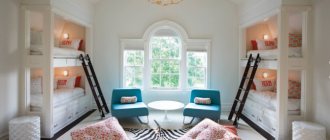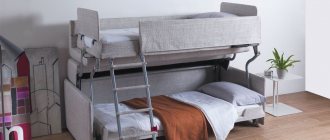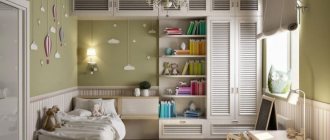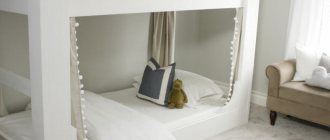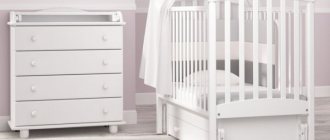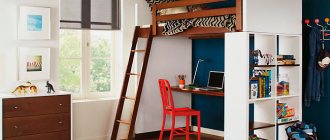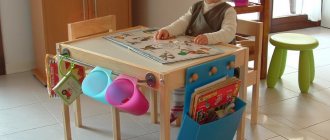- House
- Children's
Share
| The best time to buy New Year's gifts is right now! Find the best gift ideas for Men, Women, Girls and Boys. |
A small living area, in this case a one-room apartment, leaves very few options for redevelopment when parents share one room with a child. However, changes should occur only because a new life brings with it a lot of responsibilities on the part of the parents and a lot of impressions on the part of the child.
But don’t be upset in advance, because today experienced designers have created the most successful techniques that are easy to implement even in a small apartment. The main goal of the redevelopment is to functionally use every meter so that each family member can find their own place to their liking.
- 1 Rules for effective zoning
- 2 Correctly designed interior depending on the age of the child 2.1 Preschooler and his apartment
- 2.2 7 years - new changes
How to properly decorate the space of a small apartment?
- Minimalism . A small apartment will look much more spacious if you place a minimum of things in it. It is better to choose furniture with simple geometric shapes, without unnecessary details, stucco molding, curly corners and an abundance of shelves. It is also worth giving up a large number of souvenirs and trinkets.
- Indoor flowers in small pots, it is better to place them in one corner on a multi-tiered stand, or replace them with one or two large plants in floor pots or hanging plant pots (in this case, the plants should be climbing climbing varieties)
- Built in furniture . If the apartment has niches, large corners, long walls, they need to be filled with built-in wardrobes. Such furniture does not “eat up” excess space, but at the same time it can accommodate quite a lot of things, especially with proper planning of shelves, drawers and hooks
- Transformable furniture is an excellent solution for a small apartment. It is very convenient when the side wall of the closet turns into a folding bed at night, one children's sofa can be laid out as multi-tiered pull-out mattresses, and a compact coffee table, if necessary, turns into a festive table for a large company
- Modules for compact storage . Use any space to organize additional storage modules: drawers under the sofa, armchairs and couches with a hollow drawer under the seat, mezzanines in non-residential premises: corridors, closets, a pocket in the entrance
- Simple style . The ideal design option for small apartments would be Scandinavian or high-tech style: a lot of light and a minimum of details. Classic heavy furniture, decoration in Provence or Art Deco style are suitable for spacious apartments. Such options will visually significantly reduce your already small room to the size of a birdhouse
- Place under the ceiling . For apartments with ceilings of 3 meters or higher, a good solution would be to use the vertical space of the room: additional sleeping places, storage modules or play areas for children can be placed on the “second floor”
- Multifunctional interior details. The end of the wardrobe can be turned into a bookcase, a wide double bed can be pulled out and hidden for the day under a podium on which a work area can be placed, a children's compact wall can simultaneously include a wardrobe, a sleeping place and a desk
- Use the balcony space . A well-insulated balcony should be used as additional living space. If this is a full-fledged loggia, make it an additional room: a study, a children's bedroom or a play area. A small balcony can be combined with a room by partially or completely removing the partition
- Visual techniques . Several classic design techniques will help you visually expand the space of your room: mirrors and mirrored cabinet doors, reflective surfaces (including suspended ceilings), light colors in the design
- Color palette . Light shades visually make the room larger. Use light wood for flooring and furniture, and light paint for walls and ceilings. Dark, rich colors of walls and floors visually compress the size of the room. Many dark-colored furniture pieces also take up space. Ideal option: a room in light colors with several bright colored accents: pillows on the sofa, a large plain vase made of bright glass, a chandelier
- Textiles . You should absolutely not use dark dense fabrics for curtains or furniture upholstery in interior design for a small apartment. If the number of floors allows and there are no closely located houses in the neighborhood, you can abandon curtains completely, leaving translucent organza on the windows to match the main interior or harmonize with bright color accents
- Light . Small rooms need bright lighting. If your apartment looks dull in daylight, use as much white and reflective surfaces as possible. Artificial lighting should also not be limited to one common chandelier.
- Make sure that each area of the apartment (work area, children's corner, play area, sleeping areas) has separate lighting sources: table lamps, floor lamps or sconces. You can use LED strips that are attached behind furniture or along the perimeter of the ceiling and above shelves. Avoid bulbs with cold, bluish light. It's better if the lighting is golden
Types of children's corners
Depending on the age of the child, the needs of the child change, but the place for sleeping, playing sports and playing remains the same. To organize a children's area, it is better to choose multifunctional furniture, when the bed can be extended in length and the wall bars can be increased in height.
The play area is transformed into a table for schoolchildren to study.
Sports section
The presence of pull-up bars on the wall, rings on the ceiling and a punching bag for boxing is a must for a child. If the room is small and there is not much space for installing sports equipment, a minimal set will be enough; allocate a part of the wall and ceiling in the children's area.
It is better to choose the style of a combined bedroom: modern, universal, classic in light neutral colors.
To save space, purchase an L-shaped sports corner, which will take up little space in the room and provide children with full physical development.
When there is one child in the family, a mini-sofa can be placed in the room, transforming into a comfortable bed.
If you have 4-5 free square meters, you can organize a small gym with a treadmill, an exercise bike and a climbing wall. When purchasing, pay attention to the presence of a soft mat on the floor to avoid bruises and injuries.
There must be a window in this area, and the room must be constantly ventilated.
Sleeping area
The sleeping area should be as private and private as possible, regardless of the baby’s age. The presence of drawers under the bed will ensure relative order in the nursery and teach the child to have order in his corner. Pay attention to the multifunctional sleeping places, where there is a bed, a table for studying, a wardrobe and a small Swedish wall.
This is the best option for placing everything you need in a small area.
If a new addition is expected in your home, it is better to immediately provide sleeping space for two children. Two-tier multifunctional furniture, where on the second floor there is a bed for the older child, and on the first floor there is a table that folds out into a sleeping place for the baby. This will save you from additional costs for replacing furniture in the future.
If the room is designed for parents and two children, it is recommended to install a bunk teenage bed.
Game corner
The play area is most often organized for preschool children and is of great importance in the development and broadening of their horizons. Mandatory attributes of the play area should be: a table for educational games and preferably with two chairs, one for the child and the other for parental participation, and a small rug on the floor for assembling construction sets and houses from cubes. Furniture in the form of a chest of drawers for toys and a small shelf for books and first crafts.
If possible, install a small hut for a boy and a dollhouse for a girl.
If you take into account the wishes of the baby and the child’s predisposition to certain games, you can create a small kingdom in which it will be cozy and interesting at any age.
Racks, shelves and other furniture must be securely fastened.
How to arrange furniture in a small room
The arrangement of furniture depends on the geometry of the room.
- It is better to divide a long, elongated room into zones with partitions in the form of cabinets, shelving, or plasterboard structures. Closer to the window there are desks and play areas for children; It is better to place sleeping places in the darkest areas
- If the room is a square, the furniture should be placed along the walls, highlighting the areas with a color accent. It is better to leave the center of the room free as a play area for the child
- A wide rectangular room can be divided into a nursery and a living room. It is not necessary to make a partition; zoning can be done using furniture or visual accents
- If the room is of irregular shape, it is necessary to visually bring the shape of the room to the correct geometric shape using built-in cabinets and wall shelves and then use the above recommendations
We place the nursery in a two-room small apartment
Actually, in typical Khrushchev and Brezhnev buildings there are not many options: either settle a child in the walk-through room, or live there yourself. Which decision is right for you?
Children under three years of age will be most comfortable with their parents. A crib will not take up much space, so we boldly set aside a walk-through room for the living room, and in the back room we set up a bedroom for the whole family. In this case, it is better to place the baby’s crib where there is more space.
Children of preschool and school age must have a separate bedroom. In this case, you will have to donate the back room to the child. The walk-through room in such apartments is doomed to be a living room, no matter who spends the night in it. Functionally combining a living room and an adult bedroom is easier than combining a living room and a children's room. In addition, the child requires adherence to a routine and silence during sleep, which cannot always be provided in a walk-through room.
Recommendations for decorating niches in one-room apartments
Before deciding what the functional purpose and external design of the room will be, you should listen to a few tips:
- When colorizing a niche, use lighter shades. This will avoid a dark spot inside the space.
- Find out the general dimensions of the room and the recess, as well as their geometric parameters. So, for example, if the niche is quite narrow, then you should not use tall furniture in it, as this will visually stretch this small space even more.
- When choosing lighting fixtures, give preference to small-sized ones so that they do not draw attention to themselves and do not take away part of the volume of the room from the point of view of visual perception.
How to choose flooring for a children's play area?
The space in the apartment reserved for your child’s play area should be cozy, warm and safe. The best option is a carpet, which, in addition to its important practical function, can serve as a bright spot of color and an additional decorative element.
- Synthetic carpets of the latest generation (we are talking about high-quality manufacturers who supply their products with a mandatory hygienic quality certificate, for example IKEA) are safe for health, hypoallergenic and very easy to care for.
- Wool carpets can cause allergies, accumulate static electricity, are difficult to clean at home and are much more expensive. But they have a plus that is significant for cold rooms: woolen carpets are much warmer than synthetic ones
- Carpets with long pile are not suitable for children's games. Small toys and objects are easily lost in them, they are difficult to clean, babies pull lint into their mouths, and older children involuntarily cling to long threads of the carpet, creating puffs and bald patches, which can spoil the appearance of the carpet quite quickly
- The color of the carpet should be bright and interesting for the child. Now in stores there is quite a large selection of children's carpets with bright designs: the alphabet, colorful streets and cars, fairy tale characters, flower meadows and much more.
When choosing the color of the carpet, be sure to take into account the character and age of your child. Avoid monochromatic carpets in inexpressive or dark tones - such colors have a depressing effect on the child’s psyche
How to decorate the walls in the children's area? Design ideas
If a child has a small room, but separate from adults, there will not be any special problems with decorating the walls. It will be important to choose a suitable material for covering the walls (eco-friendly, natural, easy to clean) and a color that matches the overall style of the room and the child’s tastes.
It is more difficult to design a children's area when the child lives in the same room with his parents. The overall tone of such a room is usually light and neutral. How not to disturb the visual balance of the room and at the same time make the children's corner interesting and cozy for the child?
- Hang on the wall some of the brightest drawings by the little artist. Decorate them like real paintings - choose frames that match the color or paint a simple baguette yourself
- Vinyl wall stickers are an excellent solution for highlighting a children's area. Such stickers are sold in almost every hypermarket for repairs; they easily fit into the interior, are easy to clean, and are made of materials that are safe for children. As the sticker wears out, you can quickly replace it with another one.
- You can buy a set of children's creativity and create a wall decoration with your child: an applique made of bright felt, a picture made of multi-colored sand, hand-painted fabric in a frame, or something like that. In specialized stores and departments for creativity there is a very large selection of such sets, you can easily find something suitable
- You can puzzle your beloved grandmothers with the design. Hand-knitted small napkins, rugs, patchwork flags or felted figurines can serve as material for an original garland over a child’s bed
Choosing a color palette for a niche
When considering color palette options, here are the basic rules to pay attention to:
- If there is no separate window in the niche, use the lightest possible shades. This is important in conditions where there is no natural light. Moreover, it is highly not recommended to choose cold colors. Warm ones will look better and psychologically more comfortable.
- If a niche is obtained by dividing the room into 2 parts and this compartment has its own window, then you can play with color in a wide variety of ways. Here everything will depend only on individual preferences.
The choice of color for finishing a niche directly depends on the degree of illumination of the recess
The only thing that experts still recommend is to take into account the color scheme in which the rest of the house is decorated.
Color design for the nursery. What needs to be taken into account in the interior?
- Forget the traditional colors of pink for girls and blue for boys. Choose a color based on the character and natural characteristics of the child.
- Bright, saturated colors and accents will suit slow and hyper-calm children.
- For active fidgets, it is better to decorate the area in soothing pastel colors
- Remember that the main background of the children's corner should be light; rich colors may be present fragmentarily in the form of color spots (pillows, baby blanket, picture frame)
- Avoid combinations of white and black or gray. This combination is too contrasting and disturbing for the child’s psyche
- Children's color perception differs from that of adults. They need colors and lines that evoke bright positive emotions. Avoid sharp, angular patterns and eye-catching color combinations when decorating.
- The living space of a baby greatly influences his psyche. The child perceives individual bright spots on a light background most comfortably
- Be attentive to patterns and patterns on textiles and wallpaper - they should not be too intrusive and annoying.
- In general, it is better to decorate only one wall in the room with wallpaper with ornaments - this will visually increase the space and correctly place color accents
- Consult with your child on the design. After all, this is his corner and his tastes must be taken into account.
- Use his favorite colors and textures in the design
- Don't choose materials that are too expensive. Remember that children grow very quickly, and children's tastes change greatly with age.
- Decorate the room so that in six months you won’t mind repainting everything
How to choose the right furniture for the children's area
- The best material for making children's furniture is natural wood or safe, durable plastic.
- You should avoid furniture with sharp corners, protruding edges, and unreliable construction.
- For schoolchildren, it is better to arrange the furniture so that the work area is as far as possible from the play and sleeping areas
- Furniture for a child should not just be functional. It should develop aesthetic taste and teach the child to have order.
- If you are partitioning off a children's area in a common room, it is better to use a small cabinet or rack instead of bulky partitions or tall cabinets.
- Objects that are too tall and narrow spaces can make a child feel afraid and feel claustrophobic.
Sports corner for children
Each child is gifted with one or another ability and each is talented in his own way, but almost every child loves sports games, which include: climbing stairs, ropes, horizontal bars, etc. In order for the design of a one-room apartment to combine a sports corner, the work area should be properly designed, because often the sports corner is a Swedish wall.
It would be logical to install this corner opposite the bed against the wall, and put a voluminous mat underneath, this point is especially important if you teach your child from an early age. Very often small slides and swings are offered for small children. In our case, you can buy them removable, which are then removed and hidden in a secret place.
Today, manufacturers of sports corners offer their consumers special wall mounts on which they can easily hang a bicycle or scooter.
Space for a child is an important component in the overall ambiance of a room. Interior design is not a simple matter, but it can be solved. Thoroughly prepared parents have all the powers to develop their child into a worthy personality, the main thing is not to infringe on his personal space. Check out the photos of designers who offer to skillfully combine the lives of parents and the younger generation.
The best gifts for the New Year:
|
Residential mezzanine - an idea for additional space for a children's area
If the ceiling height of your apartment is 3 meters or more, you can arrange an additional living area - a mezzanine. It can accommodate an extra bed, a reading corner, a small wardrobe, a play area or a small cinema room.
The biggest fans of residential mezzanines are children. For them, the mezzanine is their own cozy world in the parents’ room. The size of the mezzanine depends on the overall size and interior of the room: it can be a small balcony, or it can be a full-fledged mini-room with its own furniture.
What is important to consider when building a mezzanine for a child.
- In order for a child to move safely on the mezzanine, its length must be at least two meters and its width must be at least 70 cm. Avoid sharp corners and protrusions
- Make sure that the mezzanine has sufficient strength and proper design to withstand the load for which it is designed
- Place the stairs to the mezzanine so that it does not interfere with the daily life of other family members
- The height of the steps must correspond to the age of the child. Too narrow steps or too wide a flight creates a traumatic situation
- The lighting of the mezzanine, including the stairs, should be bright enough, and the lamps should be safe for children
- It is necessary to think carefully about ventilation, since at the top of the room the air is always warmer and stuffier than at the bottom
- The mezzanine and stairs must be equipped with reliable and safe railings. The design of the railing should be comfortable so that the child can firmly grasp it with his hand
- To make a mezzanine, it is best to use natural wood - the most environmentally friendly and healthy material for children. The steps and edges of the mezzanine must be covered with special anti-slip flooring material
- You should not place a work area for schoolchildren on the mezzanine, as there is too little light there
- Toys should not be stored on the mezzanine: small objects, construction sets, blocks, sports equipment and traumatic items
- If you have a certain amount of imagination, the children's mezzanine can be turned into a real magical land
